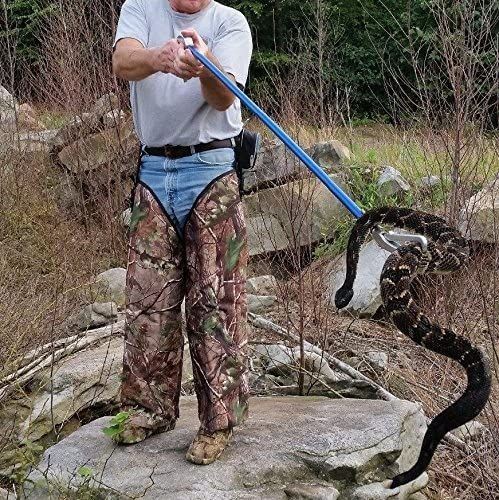Finding snakes in your pond can be a scary proposition.
Not only can they diminish enjoyment of your pond, but they can also kill your pond’s fish. Do you live in an area that tends to attract snakes? If yes, it is important to know how to get rid of them and keep them out permanently.
Before you start looking for ways and means to be free of snakes, there are certain things you should know. For one, not all snakes are poisonous. And, you should know a bit about the difference between a venomous snake and a harmless one. In the case of venomous snakes, you have to get professional help. If it is a non-venomous snake, you can use our tips below.
Table of Contents
Types of Snakes Found in Water
There are nearly 200 snake species of the semi-aquatic type you can find in water or near it.
Typically, a water snake has a stout body, a triangular head, and scales that are well-keeled. Such snakes are more common to the Northern Hemisphere. Although most of them are non-venomous, they bite freely and are ill-tempered.
How to identify snakes.
The Nerodia species is the most commonly found in North America and consists of 11 species. The prevalently seen Nerodia types are given below:
- Northern Water Snake: These are found in the northeastern part of the United States and can extend as far as Georgia, Mississippi, and Kansas in the far west. These are large and can reach up to 5 feet. The snakes are gray, brown, or tan. These snakes are frequently confused with water moccasins.
- Southern/Banded Water Snake: Found along the southeastern coast of the United States, these snakes can be found from Alabama up to North Carolina. They have dark crossbands and are light brown or reddish to black.
- Yellow-Bellied Snake: Colored black, green, or gray with a yellow underside, these snakes are mostly confined to the Gulf Coast, including Iowa, Texas, and Georgia regions.
- Red-Bellied Snake: With a gray or brown unmarked back, these snakes have an orange or red colored underside.
- Lake Erie Snake: Found in the islands and rocky shores of Lake Erie, this type of water snake is a soft gray with band pattern.
How To Get Snakes Out Of A Pond
Before you try getting a snake out of your pond, ensure that it is not venomous. Only professionals can deal with such snakes. But, if you know that the snake is not harmful, you can use the following methods:
• One simple way is to use a pond or pool skimmer to scoop the snake out and release it over the fence or an area far from your location.
• A poker, broom, or mop can also be used instead of the net to lift the snake out. You can place the snake inside a bag and relocate it.
• A fishing net can be used to catch the snake. Lower the net in the area where the snake is and use fake fish as bait. When the snake is lured, yank up the net, release the bait, and bag the snake.
• Bird netting can also be used. Hang the net over the top of your pond. The mesh should be small enough for the snake to get tangled.
• A snake tong can be used to get hold of the snake. The tongs offer a firm grip and you can do it from a distance safely. You can find snake tongs online here.
Precautions To Take
While grabbing the snake, make sure you avoid grabbing the head as it can injure it. But don’t grab the snake too far down its body as it may slip-free and harm you.
While relocating, just lift the head from the ground and not the entire snake and drag it to the location you want.
Pro Tip
If possible, use a net or bag to capture the snake. This way, you reduce the snake’s ability to wriggle free.
How To Keep Snakes Out Of A Pond
Sometimes relocation does not work. The snakes may keep returning to the pond. So, the best strategy is to keep snakes from entering your pond in the first place. Here are a few ways by which you can prevent snakes from going into your pond:
1. Make the region undesirable for the snake
Use the following methods to avoid snakes from nesting in your yard or entering your property.
• Keep the grass cut low in the region near the pond. This will remove any cover that snakes can hide in.
• Cut and remove all weeds and tall shrubs that form a good hiding place for snakes.
• Clean the area near the pond of large rocks, compost piles, woodpiles, tarps, and mulch. This will prevent the snakes from nesting in such areas.
• Mousetraps placed around the pond region can get rid of mice, which are a food source that attracts snakes. Remove the snake’s food and they will look for somewhere else to live.
• Snake fencing prevents snakes from entering into the pond. You can find snake fencing products online like the 100’ x 14” Snake Fence Barrier.
2. Use Snake Deterrents
Snake deterrents of different types can be used such as:
• Plants like wormwood, garlic, lemongrass, and marigold can be planted.
• Plastic toy owls set up near the pond can deter snakes, birds, and rodents.
• Essential oils such as clove oil and cinnamon oil can be mixed in water and sprayed around the pond. Snakes hate the smell and stay away.
• Snake repelling granules are made of sulfur and special oils that deter the snake but remain safe for use in your home. Use this all over the yard perimeter to prevent snakes from entering.
3. Set a Trap
Snake traps serve to trap the snakes using an appealing scent and sticky surface for trapping snakes. Avoid a kill trap; especially if your locality has endangered or protected species.
Recommendation
Don’t limit yourself to one snake repelling remedy. Mix and match any of the above methods for more effective prevention.
Frequently Asked Questions
Do water snakes float or swim on water?
All snakes can swim on the water surface. Venomous snakes float when they are stationary, while non-venomous types sink with only their head being seen above the surface of the water.
Is it best to kill a snake in my pond?
Snakes are part of the food chain and should be left alone if you do not sense any threat from them.
How do I identify a venomous snake in my pond?
Venomous snakes have a distinctly shaped head and thin neck. A non-venomous snake has a head that is continuous with its body. It has rounder pupils, while venomous snakes have vertical or elliptical pupils.
Conclusion
To avoid finding snakes in your pond, you have to take the appropriate steps to keep them out permanently.
We hope that the methods detailed above will help you get rid of the snakes in your pond. Most importantly though, ensure the snake in your pond is non-venomous before you try the above methods. If you are in doubt, contact professionals who can safely trap and relocate the snake.


